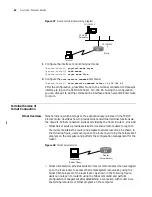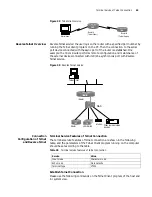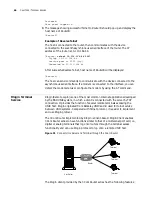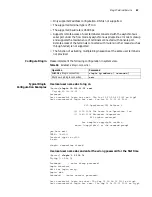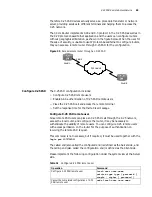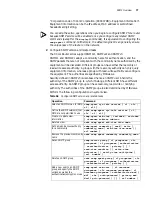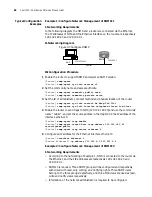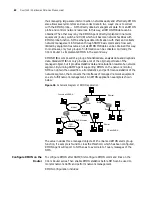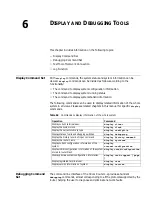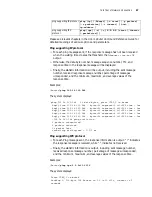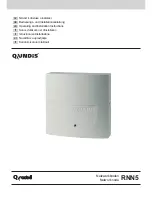
74
C
HAPTER
5: C
ONFIGURING
N
ETWORK
M
ANAGEMENT
addition to the functions defined in SNMPv2c and SNMPv1. In other words,
SNMPv3 develops SNMPv2c by adding security and management functions.
SNMPv1 and SNMPv2c lack security functions, especially in the aspect of
authentication and privacy. SNMPv1 defines only a type of community
representing a group of managed devices. Each NMS controls access to the
devices via the community name list. However, agents do not verify whether the
community names used by the senders are authorized, and they even do not
check the IDs of administrators. Additionally, transmission of SNMP messages
without encryption, which exposes the community name, brings potential threats
to security. Even though some security mechanisms, like digest authentication,
timestamp authentication, encryption and authorization, have been considered at
the early stage of proposing SNMPv2c, only the “community name” similar to
SNMPv1 is used in the final criterion of RFC 1901 through 1908. SNMPv2c is only
a transitional version between SNMPv1 and SNMPv3. To avoid the lack of security
in SNMPv1 and SNMPv2c, IETF develops the SNMPv3 protocol, which is described
in RFC2271 through 2275 and RFC2570 through RFC2575 in details.
RFC2570 through RFC2575 supplements and subdivides SNMPv3 on the basis of
RFC2271 through RFC2275, giving a complete and exact description of the
processing of abnormal errors and the message processing procedure. The
SNMPv3 framework thus defined has become a feasible standard.
Security of SNMPv3 is mostly represented by data security and access control.
■
Data security features provided in SNMPv3
Message-level data security provided in SNMPv3 includes the following three
aspects:
■
Data integrity. It ensures that data will not be tampered with by means of
unauthorized modes and the data sequence will only be changed within the
permitted range.
■
Data origin authentication. It confirms which user the received data is from.
Security defined in SNMPv3 is user-based. Hence, it authenticates the users
that generate messages instead of the particular applications that are used
to generate the messages.
■
Data confidentiality. Whenever an NMS or agent receives a message, it will
verify when the message is generated. If the difference between the
generating time of message and the current system time exceeds the
specified time range, the message will be rejected. Thereby, it ensures that
the message has not been tampered with in-transit on the network and
prevents processing of received malicious messages.
■
Access control in SNMPv3
As a security measure, access control defined in SNMPv3 implements a security
check on the basis of protocol operations, thereby to controlling access to the
managed objects.
MIB accessible to a SNMP entity is defined by the particular context. For
security reasons, different groups and corresponding authorities probably need
to be defined on one entity. The authorities are specified by the MIB view. A
MIB view specifies a collection of managed object types in the context. The MIB
view takes the form of a “view sub-tree” to define objects because MIB adopts
the tree structure. If the flag of the object to be accessed belongs to the MIB
Содержание 3036
Страница 1: ...http www 3com com 3Com Router Configuration Guide Published March 2004 Part No 10014299 ...
Страница 4: ...VPN 615 RELIABILITY 665 QOS 681 DIAL UP 721 ...
Страница 6: ...2 ABOUT THIS GUIDE ...
Страница 7: ...I GETTING STARTED Chapter 1 3Com Router Introduction Chapter 2 3Com Router User Interface ...
Страница 8: ...4 ...
Страница 16: ...12 CHAPTER 1 3COM ROUTER INTRODUCTION ...
Страница 34: ...30 ...
Страница 60: ...56 CHAPTER 3 SYSTEM MANAGEMENT ...
Страница 88: ...84 CHAPTER 5 CONFIGURING NETWORK MANAGEMENT RouterA interface ethernet 0 RouterA Ethernet0 rmon promiscuous ...
Страница 98: ...94 CHAPTER 6 DISPLAY AND DEBUGGING TOOLS ...
Страница 110: ...106 ...
Страница 114: ...110 CHAPTER 8 INTERFACE CONFIGURATION OVERVIEW ...
Страница 158: ...154 CHAPTER 10 CONFIGURING WAN INTERFACE ...
Страница 168: ...164 ...
Страница 188: ...184 CHAPTER 13 CONFIGURING PPPOE CLIENT ...
Страница 192: ...188 CHAPTER 14 CONFIGURING SLIP Router ip route static 0 0 0 0 0 0 0 0 10 110 0 1 ...
Страница 248: ...244 CHAPTER 16 CONFIGURING LAPB AND X 25 ...
Страница 292: ...288 CHAPTER 18 CONFIGURING HDLC Enable HDLC packet debugging debugging hdlc packet interface type number ...
Страница 320: ...316 ...
Страница 330: ...326 CHAPTER 20 CONFIGURING IP ADDRESS ...
Страница 362: ...358 CHAPTER 21 CONFIGURING IP APPLICATION ...
Страница 374: ...370 CHAPTER 23 CONFIGURING IP COUNT ...
Страница 406: ...402 CHAPTER 25 CONFIGURING DLSW ...
Страница 408: ...404 ...
Страница 452: ...448 CHAPTER 29 CONFIGURING OSPF ...
Страница 482: ...478 CHAPTER 30 CONFIGURING BGP ...
Страница 494: ...490 CHAPTER 31 CONFIGURING IP ROUTING POLICY ...
Страница 502: ...498 ...
Страница 508: ...504 CHAPTER 33 IP MULTICAST ...
Страница 514: ...510 CHAPTER 34 CONFIGURING IGMP ...
Страница 526: ...522 CHAPTER 36 CONFIGURING PIM SM ...
Страница 528: ...524 ...
Страница 532: ...528 CHAPTER 37 CONFIGURING TERMINAL ACCESS SECURITY ...
Страница 550: ...546 CHAPTER 38 CONFIGURING AAA AND RADIUS PROTOCOL ...
Страница 590: ...586 CHAPTER 40 CONFIGURING IPSEC ...
Страница 599: ...IX VPN Chapter 42 Configuring VPN Chapter 43 Configuring L2TP Chapter 44 Configuring GRE ...
Страница 600: ...596 ...
Страница 638: ...634 CHAPTER 43 CONFIGURING L2TP ...
Страница 649: ...X RELIABILITY Chapter 45 Configuring a Standby Center Chapter 46 Configuring VRRP ...
Страница 650: ...646 ...
Страница 666: ...662 ...
Страница 670: ...666 CHAPTER 47 QOS OVERVIEW ...
Страница 700: ...696 CHAPTER 49 CONGESTION MANAGEMENT ...
Страница 706: ...702 CHAPTER 50 CONGESTION AVOIDANCE ...
Страница 707: ...XII DIAL UP Chapter 51 Configuring DCC Chapter 52 Configuring Modem ...
Страница 708: ...704 ...
Страница 762: ...758 CHAPTER 52 CONFIGURING MODEM ...



